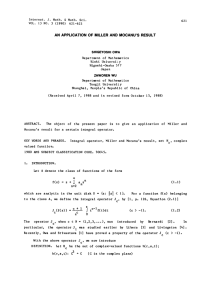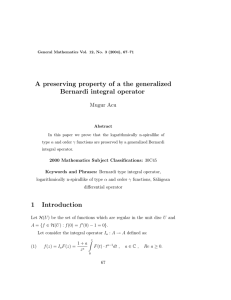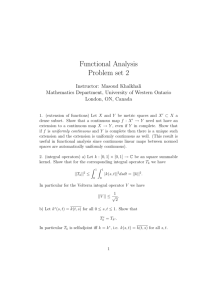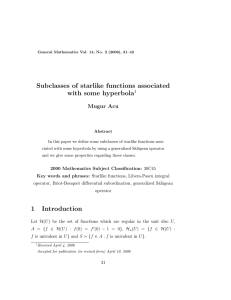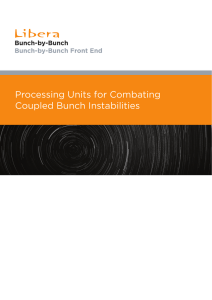A preserving property of a generalized Libera integral operator Mugur Acu
advertisement
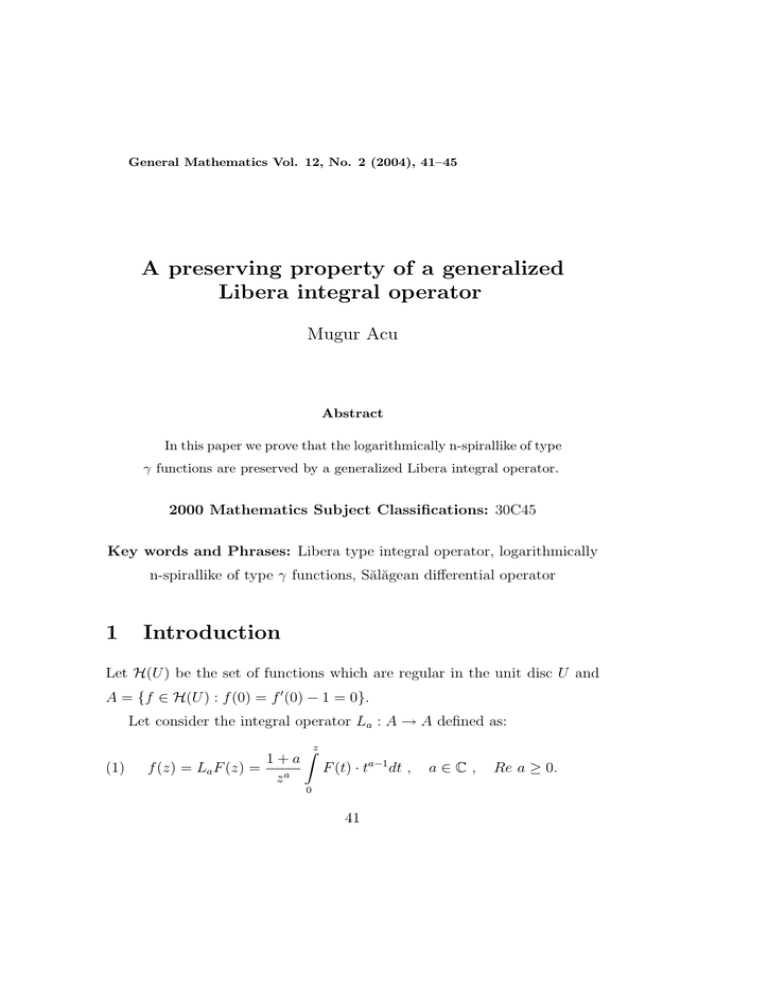
General Mathematics Vol. 12, No. 2 (2004), 41–45
A preserving property of a generalized
Libera integral operator
Mugur Acu
Abstract
In this paper we prove that the logarithmically n-spirallike of type
γ functions are preserved by a generalized Libera integral operator.
2000 Mathematics Subject Classifications: 30C45
Key words and Phrases: Libera type integral operator, logarithmically
n-spirallike of type γ functions, Sălăgean differential operator
1
Introduction
Let H(U ) be the set of functions which are regular in the unit disc U and
A = {f ∈ H(U ) : f (0) = f ′ (0) − 1 = 0}.
Let consider the integral operator La : A → A defined as:
(1)
1+a
f (z) = La F (z) =
za
Zz
F (t) · ta−1 dt ,
0
41
a∈C,
Re a ≥ 0.
42
A preserving property of a generalized Libera integral operator
If we consider a = 1 we obtain the Libera integral operator and for
a = 0 we obtain the Alexander integral operator. In the case a = 1, 2, 3, ...
this operator was introduced by S. D. Bernardi and it was studied by many
authors in different general cases.
Let Dn be the Sălăgean differential operator (see [7]) defined as:
Dn : A → A ,
n ∈ N and D0 f (z) = f (z)
D1 f (z) = Df (z) = zf ′ (z) ,
2
Dn f (z) = D(Dn−1 f (z)).
Preliminary results
Definition 2.1. Let f ∈ A and n ∈ N. We say that f is a n-starlike
function if:
Re
Dn+1 f (z)
> 0 , z ∈ U.
Dn f (z)
We denote this class with S ∗ n .
Definition 2.2. Let f ∈ A and n ∈ N. We say that f is logarithmically
³ π π´
if Dn f (z) 6= 0 , z ∈ U and
n-spirallike of type γ ∈ − ,
2 2
·
¸
n+1
f (z)
iγ D
Re e
> 0, z ∈ U .
Dn f (z)
We denote this class with Sγ,n .
Remark 2.1. If we consider γ = 0 we obtain the concept of n-starlike
functions and for n = 0 we obtain the classical spirallike functions. We
denote the set of all spirallike functions with Sγ .
The next theorem is result of the so called ”admissible functions method”
introduced by P. T. Mocanu and S. S. Miller (see [2], [3], [4]).
43
Mugur Acu
Theorem 2.1. Let h convex in U and Re [βh(z) + δ] > 0. If q ∈ H(U )
zq ′ (z)
≺ h(z), then q(z) ≺ h(z).
with q(0) = h(0) and q satisfied q(z) +
βq(z) + δ
3
Main results
Theorem 3.1. If F (z) ∈ Sγ,n then f (z) = La F (z) ∈ Sγ,n .
Proof. By differentiating (1) we obtain
(1 + a)F (z) = af (z) + zf ′ (z) .
By means of the applications of the linear operator Dn+1 we obtain:
(1 + a)Dn+1 F (z) = aDn+1 f (z) + Dn+1 (zf ′ (z))
or
(1 + a)Dn+1 F (z) = aDn+1 f (z) + Dn+2 f (z) .
It is easy to see that in the conditions of the hypothesis we have Dn f (z) 6=
0 , z ∈ U.
Dn+1 f (z)
= p(z), where p(z) = 1 + p1 z + ...., by simple
With notation
Dn f (z)
calculations we obtain
Dn+1 F (z)
1
=
p(z)
+
· zp′ (z) .
Dn F (z)
p(z) + a
From here we have
eiγ
eiγ
Dn+1 F (z)
iγ
=
e
p(z)
+
· zp′ (z) .
Dn F (z)
p(z) + a
If we denote eiγ p(z) = q(z) we obtain
(2)
eiγ
Dn+1 F (z)
1
= q(z) + −iγ
· zq ′ (z) .
n
D F (z)
e q(z) + a
44
A preserving property of a generalized Libera integral operator
1 + z iγ
e which is convex in U and maps the unit
1−z
disc into a convex domain included in the right half plane, then using the
If we consider h(z) =
hypothesis from (2) we obtain:
q(z) +
1
e−iγ q(z)
+a
· zq ′ (z) ≺ h(z) .
£
¤
In this conditions, using Re a ≥ 0, we obtain Re e−iγ h(z) + a > 0. From
Theorem (2.1), with β = e−iγ and δ = a, we have q(z) ≺ h(z) or
eiγ p(z) = eiγ
Dn+1 f (z)
1+z
≺ h(z) ≺
.
n
D f (z)
1−z
¸
·
n+1
f (z)
iγ D
> 0 , z ∈ U or f (z) = La F (z) ∈ Sγ,n .
Thus we obtain Re e
Dn f (z)
If we take γ = 0 in Theorem (3.1) we obtain:
Corollary 3.1. If F (z) ∈ Sn ∗ then f (z) = La F (z) ∈ Sn ∗ .
Remark 3.1. In the case n = 0 from Theorem (3.1) we obtain:
If F (z) ∈ Sγ then f (z) = La F (z) ∈ Sγ .
This result is a particular case of the more general results given by P.T.
Mocanu and S.S. Miller in [5] and [6].
References
[1] S. G. Gal and P. T. Mocanu, On the analytic n-starlike and n-spirallike
functions, Mathematica, Tome 43(66), No. 2(2001), 203-210.
[2] S. S. Miller and P. T. Mocanu, Differential subordination and univalent
functions, Mich. Math. 28(1981), 157-171.
Mugur Acu
45
[3] S. S. Miller and P. T. Mocanu, Univalent solution of Briot-Bouquet
differential equation, J. Differential Equations 56(1985), 297-308.
[4] S. S. Miller and P. T. Mocanu, On some classes of first-order differential
subordination, Mich. Math. 32(1985), 185-195.
[5] S. S. Miller and P. T. Mocanu, On a class of spiralike integral operators,
Rev. Roum. Math. Pures Appl., 31, 3(1986), 225-230.
[6] S. S. Miller and P. T. Mocanu, Classes of univalent integral operators,
J. Math. Anal. Appl., 157, 1(1991), 147-165.
[7] Gr. Sălăgean, Subclasses of univalent functions, Complex Analysis. Fifth
Roumanian-Finnish Seminar, Lectures Notes in Mathematics, 1013,
Springer-Verlag, 1983, 362-372.
University ”Lucian Blaga” of Sibiu
Department of Mathematics
Str. Dr. I. Rat.iu, No. 5-7
550012 - Sibiu, Romania
E-mail address: acu mugur@yahoo.com
